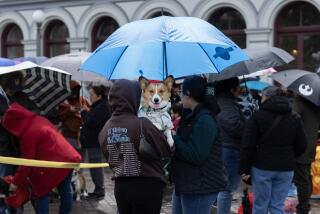Op-Ed: Remembering an L.A. priest who gave sanctuary to immigrants during Reagan era
Saturday is the feast day of Our Lady of Guadalupe, the patron saint of Mexico and Mexicans in the United States. It is also the 30th anniversary of the day Father Luis Olivares, the charismatic Roman Catholic priest, declared La Placita Church in downtown Los Angeles a sanctuary for Central American refugees.
Like Syrians today, many regarded the Central Americans as “illegal aliens,” criminals or potential criminals. But for Olivares, they were children of God.
Born in San Antonio in 1934 and educated for the priesthood in Southern California, Olivares was a good company man and not a political activist at first. However, by his own admission, when he first met César Chávez in 1975, he underwent a “conversion.” He realized that the main role of a Catholic priest should be to minister to the poor and oppressed, including farmworkers and disenfranchised Mexican Americans in East Los Angeles. As the pastor of Our Lady of Solitude Church (“La Soledad”) in the barrio, he became a member of the grass-roots United Neighborhoods Organization.
Perhaps [the sanctuary movement] is due for a revival, as hundreds of thousands flee escalating violence in the Middle East and -- once again -- in Central America.
In 1981, Olivares was transferred to La Placita. His transfer coincided with the influx of thousands of migrants from El Salvador, Guatemala and other war-torn Central American countries who by the end of the decade would number half a million in Los Angeles.
The Reagan administration denied these desperate men, women and children political refugee status and instead labeled them illegal aliens. As undocumented immigrants, the Central Americans were subject to arrest and deportation. Olivares, however, rejected this classification as unjust. Working with Father Michael Kennedy, a Jesuit priest, Olivares fed, clothed and provided medical assistance to the refugees; he helped them find jobs and even housed some of them in La Placita Church, where they slept in the pews.
But he wanted to do even more. He wanted to publicly declare La Placita a sanctuary church.
Led by liberal Protestants, the American sanctuary movement drew on the biblical and historical tradition of shielding the oppressed in houses of worship. Beginning in 1981, Protestant churches spread the word that they were havens for refugees. Of course ministers could not prevent immigration officials from entering in search of Central Americans, but at least refugees could rest assured that no one would turn them in.
Although the Catholic hierarchy in the United States was leery of challenging the government, Olivares believed that declaring sanctuary was the right thing to do. Not because he wanted to thumb his nose at the Reagan administration, but because he thought a higher law — God’s law — took precedence. Citing biblical verses, Olivares stressed that he and other people of God had an obligation to embrace the poor, the oppressed, the immigrant and the refugee — the stranger. Often he pointed to Leviticus 19:33: “When aliens reside with you in your land … you shall treat them no differently than the natives born among you.”
On Dec. 12, 1985, with the sound of mariachis playing and hundreds of people in attendance, Olivares celebrated Mass in honor of Our Lady of Guadalupe. Two masked Central American families, disguised for their protection, shared their stories. Olivares then asked the congregation to join him in making the declaration of sanctuary.
“We are gathered here together today,” he said, “with a long tradition of how our faith has taught us to stand with the poor and oppressed especially exemplified by this Feast of Our Lady of Guadalupe who chose to protect a simple peasant [Juan Diego].”
La Placita became the heart and soul of the sanctuary movement in Los Angeles and the most recognized sanctuary church in the country. In 1987, Olivares expanded sanctuary to include undocumented Mexican immigrants.
His actions were controversial, to say the least. Members of a self-styled Salvadoran death squad threatened his life because they regarded the refugees as communists. The regional commissioner of the Immigration and Naturalization Service, Harold Ezell, said Olivares was “promoting lawlessness.” Federal officials investigated his church. And the archbishop of Los Angeles, Roger Mahony, took issue with his confrontational style. Instead of trying to appease his critics, Olivares spoke out against U.S. military aid to El Salvador.
Eventually, tensions with archdiocesan officials, especially Mahony, led the Claretian Order to reassign Olivares to Fort Worth. He left La Placita in 1990 but, because of his declining health, he never actually left Los Angeles. He died in 1993.
The sanctuary movement subsided in the 1990s, when Central Americans were finally allowed to petition for legal immigrant status. But perhaps it’s due for a revival, as hundreds of thousands flee escalating violence in the Middle East and, once again, in Central America. If churches open their doors — literally and symbolically — to the new refugees, they might encourage other Americans to also welcome them and assist them in their time of need.
Mario T. García is professor of Chicano studies and history at UC Santa Barbara. He is writing a biography of Father Luis Olivares.
Follow the Opinion section on Twitter @latimesopinion and Facebook
More to Read
A cure for the common opinion
Get thought-provoking perspectives with our weekly newsletter.
You may occasionally receive promotional content from the Los Angeles Times.






